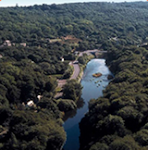Blog post courtesy of fellow Wrekin Forest Volunteer - Keith Fowler
Pete got some money to permit the coppicing of the section of woodland at the Dairypits on the Ercall that we had started in Festive Mood for our Christmas day out. Unfortunately as the job had to be completed in a short time it was scheduled as extra work rather than the usual Friday tasks.As we stared at the plethora of trees with our hand and bow saws at the ready some doubts about completing it did arise! But don’t say that Pete doesn’t look after us - we did have new saws and hard hats to help us.

However the chain saw gang arrived and we partitioned the area into the "beautiful handcrafted side" and the "cut ‘em down as fast as you can mechanically side".
We soon ran out of trees that we purists could handle so we had to yield to the “chain saw massacre” gang and go around clearing up after them.
After two weeks the carnage was complete and Pete decided that it was time for reinforcements so opened up the invitation to help to everyone in the group. This coincided with an unfortunate incident at Muxton Marsh that made Pete switch the Friday gang from there to the Ercall.
Some set about building a dead hedge for a deer fence whilst others collected the produce and created piles of logs for firewood, poles for the “proper” deer fencing, charcoal worthy lumps, fence stakes and rubbish. All of a sudden, we could see the wood from the trees! (Sorry tried to resist - but couldn’t.)

During our third week of work Domino the horse and his handler Phil came to clear the piles of firewood out of the coppiced area.


The Raby Estate sent their tractor and trailer to collect the wood. They estimated that we had provided about 9 tons of firewood: enough to heat a home for a year. Is that right - All that effort and wood for just one house?
The previous areas that we had coppiced had all suffered from the close attention of deer's’ habit of eating the emergent shoots which prevents the newly coppiced trees sprouting ready to be coppiced in future to complete the cycle. To combat this, deer fencing is to be erected around this new area and the one completed last year. This, thankfully, is being done by a contractor.
Unfortunately deer are canny creatures and will have no problem defeating this professionally erected fence so Pete devised a cunning plan - create an outer deer fence disguised as a dead hedge. At half the height that will outwit them!
So all hands to the fencing (apologies if I missed anyone – except Kevin who comes later):-

As different artists will paint the same subject in their own individual style so the same happened with the hedge. We ended up with a “charactful” hedge of different styles as the constructors brought their individuality to the task. See if you can identify the following five styles – I will give you a hint with one (but beware, I may be trying to mislead you):

In the process of coppicing the area we uncovered another mystery. A Pipe. Where does it go? Where does it come from? Kevin followed the pipe back from this area up the lane where there used to be a farm house so, perhaps it was a water pipe to the farm, who knows? Somebody will.

Being the Wrekin Forest Volunteers, we had fires most days and on the last day, when all was complete and we were patting ourselves on the back for a job well done we celebrated as only we can, with biscuits and baked potatoes.

.
.
.



























